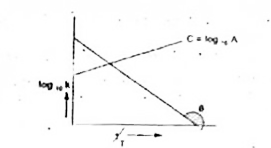K is rate constant at temp T then value of limT→∞ log K is equal to :-
A/2.303
A
2.303 A
log A
The correct Answer is:D
log K =logA−10Ea2.3RT
limT→∞logK=logA−Ea2.3RT
logA
Topper's Solved these Questions
- BOOK - ALLENCHAPTER - CHEMISTRY AT A GLANCEEXERCISE - INORGANIC CHEMISTRY300videos
CHEMISTRY AT A GLANCE
- BOOK - ALLENCHAPTER - CHEMISTRY AT A GLANCEEXERCISE - ORGANIC CHEMISTRY483videos
CHEMISTRY AT A GLANCE
- BOOK - ALLENCHAPTER - Chemical EquilibriumEXERCISE - All Questions24videos
Chemical Equilibrium
- BOOK - ALLENCHAPTER - ELECTROCHEMISTRYEXERCISE - EXERCISE -05 [B]38videos
ELECTROCHEMISTRY
Similar Questions
The rate of a reaction increases to 2.3 times when the temperature is raised form 300K to 310K. If Q is the rate constant at 300K, then the rate constant at 310K will be equal to
View SolutionThe rate of a certain reaction increases by 2.3 times when the temperature is raised form 300K to 310K. If k is the rate constant at 300K, then the rate constant at 310K will be equal to
View Solution
Knowledge Check
- Question 1 - Select One
limx→0xlogsinx is equal to
AzeroB∞C1Dcannot be determined - Question 2 - Select One
Given that k is the rate constant for some order of any reaction at temp. T then the value of limT→∞logk= (where A is the Arrhenius constant)
AA.2,303BAC2.303 ADlog A - Question 3 - Select One
The rate of a certain reaction increases by 2.5 times when the temperature is raised from 300K at 310K. If k is the rate constant at 300K then the rate constant at 310 K will be equal to
AkB2kC2.5kD3k
When the temperature is increased, heat is supplied which increases the kinetic energy of the reacting molecules. This shall increase the number of collisions and ultimately the rate of reaction shall be enhanced. Arrhenius suggested a equation which describes K as a function of temperature, i.e.
k=Ae−Ea/RT
where
k= rate constant
A= a constant (frequency factor)
Ea= energy of activation
log10k=log10A−Ea2.303R[1R]
Y=C+MX
It is the equation of straight line with negative slope. On plotting log10k against [1T] we get a straight line as shown below :

The slope gives activation energy and intercept gives frequency factor.
Also log.k2k1=Ea2.303[T2−T1T1T2]
The rate of certain reaction increases by 2.5 times when the temperature is raised from 300K to 310K. If k is the rate constant at 300K then rate constant at 310K will be equal toView SolutionIn Arrhenius equation K =Ae−Ea/RT, as limT→∞log10 K equals to:
View SolutionIf 5−k=1t, then the value of 53k is equal to :
View SolutionGraph between log k and 1/T [where K is rate constant in s−1 and T is the temperature (in K) is a straight line with Hence, Ea will be
 View Solution
View SolutionConsider the following statements.
i) Increase in concentration of rectant increases the rate of a zero order reaction.
ii) rate constant k is equal to collision frequency a if Ea=0
iii) rate constant k is equal to collision frequency A if Ea=∞.
iv) In k vs T is a straight line.
v) In k vs 1/T is a straight line.
Correct statements are:View Solution

